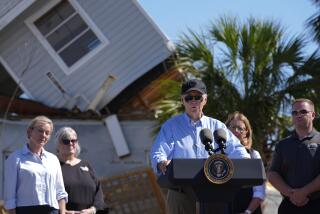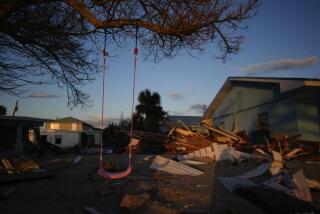‘This Is Our Tsunami’
PASCAGOULA, Miss. — Nothing. The governor kept repeating it Tuesday, sounding almost bewildered. He had just returned from touring the Gulf Coast, and for block after block, mile after mile, he had seen nothing recognizable.
The huge casino barges, vital to the state’s economy, had been swept away, toppled or crushed by the force of Hurricane Katrina. Three bridges had vanished. Thousands upon thousands of homes were gone.
“I can only imagine,” Gov. Haley Barbour said slowly, “that this is what Hiroshima looked like 60 years ago.”
In Biloxi, about 30 people died when an apartment building collapsed. Saucepans, cars, a sewing machine and bits of furniture poked out from huge piles of debris. The historic home of Jefferson Davis, onetime president of the Confederacy, was destroyed.
“This is our tsunami,” Biloxi Mayor A.J. Holloway said, comparing the devastation to the disaster in southern Asia in December that killed more than 226,000.
In Gulfport, a banana truck had been tossed into a hotel. A seal flapped helplessly in a parking lot.
Here in Pascagoula, a historic shipbuilding port in the southeast corner of the state, officials said at least 14 from the county were dead.
“And we haven’t gotten to the heavily devastated areas yet,” said Butch Loper, civil defense director for Jackson County.
On a night so black that every star in the Milky Way shone luminous, Loper tried to tally how many residents had lost all they owned to Monday’s fury of water and wind. He figured a third of the county’s 131,000 residents had lost their homes.
Even those who were lucky might not recognize their neighborhoods; the storm ripped down so many trees and swept away so many homes that the very topography was altered.
While the hurricane’s gusts did plenty of damage, the worst destruction here -- as along much of the coast -- came from the 30-foot-high wall of water that roared in from the Gulf of Mexico, swallowing everything in its path.
“All the old-timers tell me they’ve never seen water in the courthouse before,” Loper said. “There was 6 feet of water in the courthouse.”
In New Orleans, the water stayed, submerging the city under as much as 20 feet of water. It’s expected to remain for days and probably weeks. Here, the storm surge quickly receded. But it left behind chaos.
Along the entire Mississippi coastline, nearly every structure between the beach and the railroad tracks half a mile inland was destroyed.
“They’re not severely damaged. They’re simply not there,” Barbour said. “We would see 10- and 20-block areas where there was nothing. Not one house standing. There were so many places where a home had been and there was nothing left but slab. It looked like it had been swept off with a broom.”
Amid the bare slabs, a few reminders of the lost neighborhood were scattered: A church pew. A stove. A scrap of clothing. A tricycle.
“Today, I saw reporters cry,” Barbour said. “And mayors. And deputy sheriffs.”
For decades, Mississippi has measured all storms against Hurricane Camille, which slammed ashore in 1969 as one of the strongest hurricanes ever to hit the United States.
Katrina’s winds were not as forceful. But the storm surge was so powerful that officials said there was no contest. This was far worse than Camille.
“Six thousand homes were destroyed in Camille,” Barbour said. “I suspect it’s going to be higher.”
Lea Stokes of the Mississippi Emergency Management Agency said, “It looks like we’ve drawn the unlucky card again.”
Barbour said scores were dead across the state but accurate numbers were impossible to come by now. With phone lines and cellphone towers down, there was no way to communicate with the hardest-hit areas. And it will take rescue teams days, if not weeks, to pick through miles of wreckage, piled 6 feet high in many places.
In the town of Bay St. Louis, officials brushed red paint on houses where they found bodies. In many other areas, authorities were having trouble even getting to the remnants of residential neighborhoods to search for the injured or identify the dead.
As the heat and humidity soared -- with no air-conditioning, fans or cool water to splash on sweaty faces -- rescue crews fought to clear essential roads. Highway 90, which runs along the coast, was strewn with ordinary debris, huge shipping containers and even barge casinos.
The damage was so extensive across such a huge swath of southern Mississippi that at least 900,000 people were without power. Barbour said it could easily be three weeks or more before electricity was restored to many of those homes.
Though they longed for cool air and a hot meal, many were even more desperate for phone service.
They were frantic to know what had happened to friends, family and colleagues along the coast. More than 42,000 evacuees stayed in Red Cross shelters Tuesday night, and most had no way to let anyone know they had made it through.
“There’s just no telling what’s going on down there. The TV doesn’t work. The cellphone doesn’t work. The phone doesn’t work. You’re worried to death,” said Christopher Shepherd, who owns the Rotten Creek Catfish Cottage in Lucedale, about 40 miles north of the coastline. He was worried about his Alabama beach house -- and much more worried about friends who had refused to evacuate.
Cheri Margols, 41, said: “I can’t get ahold of my neighbors. I can’t get ahold of my friends. All I keep seeing is footage of trees and houses ripped from the ground and tossed about.”
On vacation in Wisconsin when Katrina hit, Margols was in the Jackson airport Tuesday night, trying to make her way to her home in south-central Mississippi -- and scared of what she might find. Her first challenge was to pick her way through airport hallways strewn with fallen ceiling tiles and snapped rafters. The airport had power, but barely -- the lights kept flickering. Dozens of people crammed in front of rental car counters, begging for four-wheel-drive vehicles or anything that would take them home.
Those lucky enough to get cars joined lines of 50 to 60 vehicles outside a Chevron station. At a Ramada Inn, every parking spot was full and the lobby was jammed; clerks kept repeating that they had no rooms.
“I don’t care what they say. They are not kicking me out of this lobby,” said Les Davis Carter, 38. Carter, who lives in Detroit, was trying to head south to find his family in Biloxi. He had not heard from them in days. “I just need a corner to curl up in and get a few hours’ sleep before I head out,” he said.
For those unable to find a corner in a hotel lobby, the Red Cross is operating 350 shelters across Mississippi and Louisiana. At one in northern Mississippi, in a Baptist church, kids chased balloons from air mattress to air mattress as their parents tried to rest. Some could think only of their losses. Others tried to remain upbeat.
“We have food and we have each other,” said Ricardo Mesa, 37, who escaped New Orleans with his family the day before the storm hit. “There is really nothing we can do. I feel God has a plan.”
Barbour, too, tried to be optimistic, vowing that Mississippi would rebuild, “bigger and better” than ever. But he also warned his exhausted fellow citizens not to expect miracles.
“I hate to say it, but my term as governor lasts for 2 1/2 more years, and for 2 1/2 more years I’m going to be standing in front of you saying: Be patient,” Barbour said. “Life as usual in Mississippi is not something we’re going to recover for a long time.... That’s just a fact.”
Dahlburg reported from Pascagoula and Huffstutter from Jackson, Miss. Times staff writer Stephanie Simon in Denver and Times researcher Jenny Jarvie in Atlanta contributed to this report.
More to Read
Sign up for Essential California
The most important California stories and recommendations in your inbox every morning.
You may occasionally receive promotional content from the Los Angeles Times.










